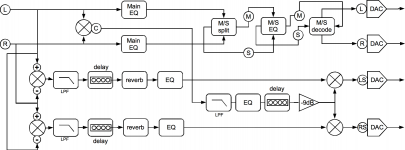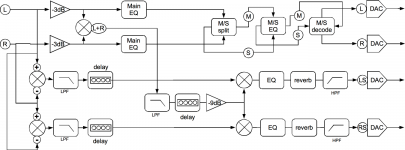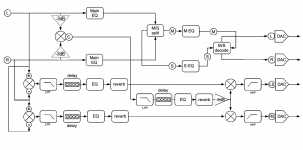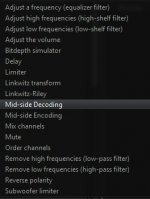What I'd like to do is draw up a generic flow chart, similar to the type you see for audio mixing consoles. I'll post it and let you tell me where it's wrong. 🙂 Then correct it.
With a sort of generic signal processing flow chart, it should be easier for others to try this on their own systems. I might break in down into 2 charts, Mains & Surrounds.
Sounds like a plan. It would be fun if more people could at least try this.
I have thought about creating a plugin that does the mid/side part. I'd have to start from scratch and learn how to create it, a bit too much to ask at this point in my life. A flow chart could help more experienced people do it though.
Here is what I think is the basic processing to achieve what you are doing with the phantom center and the ambient channels.
Some of these will be in an order different from what you are doing, but I think would do the same thing.
Please let me know what I've got wrong and right. I'll modify it and post a new one. Cheers!
Some of these will be in an order different from what you are doing, but I think would do the same thing.
Please let me know what I've got wrong and right. I'll modify it and post a new one. Cheers!
Attachments
You've done good! The only thing I see missing is a high pass crossover on the ambient side (and the L+R that gets infused).
Basically this needs to be a band passed signal. Due to size constraints I have that high pass at ~150 Hz. It may be worth it to try lower cut off values.
Also the ambient channels need to be down in level compared to the mains. How much down is a matter of taste. I'd say somewhere between 10 to 15 dB lower than mains for starters. Making it an attenuated, delayed and band passed L-R and R-L (difference) signal for completion.
Basically this needs to be a band passed signal. Due to size constraints I have that high pass at ~150 Hz. It may be worth it to try lower cut off values.
Also the ambient channels need to be down in level compared to the mains. How much down is a matter of taste. I'd say somewhere between 10 to 15 dB lower than mains for starters. Making it an attenuated, delayed and band passed L-R and R-L (difference) signal for completion.
Last edited:
Thanks! I did have some doubts. 🙂
Should the HP for the surrounds come just before the DAC?
Is there any problem with peaking in the EQs that could be helped with gain reduction along the path?
Should the HP for the surrounds come just before the DAC?
Is there any problem with peaking in the EQs that could be helped with gain reduction along the path?
One of the most important things is to split off the ambient creation and it's phantom part before any EQ on the mains, you've got that covered.
We want to split the original sound source coming in.
As the ambient part should lower in volume than mains I don't think peaking is a problem, except maybe for the sum part (L+R) Gain should probably be reduced before that step to prevent clipping.
I have my EQ in front of the reverb, not sure if this changes anything as the signal as a whole could be still be measured and EQ-ed.
With the ambience channels you're looking at the total curve over time as determining it's tonality.
The HP can be a last step in front of the DAC. I do have reverb on the phantom part that gets added to the ambient channels. I liked that best as if I didn't do that, the perceived difference between phantom center and sides could sound weird with dry recordings. The phantom center perceived from the front would sound more dry than the voices that were panned to the sides.
I still think it's best to have the ambient setup as non direct sound sources, but can't be sure as I did not try them with a direct path to the listening spot.
We want to split the original sound source coming in.
As the ambient part should lower in volume than mains I don't think peaking is a problem, except maybe for the sum part (L+R) Gain should probably be reduced before that step to prevent clipping.
I have my EQ in front of the reverb, not sure if this changes anything as the signal as a whole could be still be measured and EQ-ed.
With the ambience channels you're looking at the total curve over time as determining it's tonality.
The HP can be a last step in front of the DAC. I do have reverb on the phantom part that gets added to the ambient channels. I liked that best as if I didn't do that, the perceived difference between phantom center and sides could sound weird with dry recordings. The phantom center perceived from the front would sound more dry than the voices that were panned to the sides.
I still think it's best to have the ambient setup as non direct sound sources, but can't be sure as I did not try them with a direct path to the listening spot.
Last edited:
I re-arranged some of your flow chart, to better represent the way I have it setup, hope I didn't make a mess of it.

The reason: flexibility. I want to be able to choose different reverb settings on the phantom part that gets added to the sides. (for now they are the same in my setup)
I also split up the mid/side EQ, as the signal was already split and gets decoded afterwards. Maybe less confusing as now it's just a single EQ on each branch.
I also re-arranged the attenuation of the L+R to reflect what I do, mains do not need to be attenuated for this flow chart to make sense. In my world they are, to make room for the boosts I use, but that's not part of this game.
A separate thread? We could do that, but in which forum... for now it may get more traction here...
Anyone reading this have an opinion on that? Is there any interest in us doing this? I hope so...
The reason: flexibility. I want to be able to choose different reverb settings on the phantom part that gets added to the sides. (for now they are the same in my setup)
I also split up the mid/side EQ, as the signal was already split and gets decoded afterwards. Maybe less confusing as now it's just a single EQ on each branch.
I also re-arranged the attenuation of the L+R to reflect what I do, mains do not need to be attenuated for this flow chart to make sense. In my world they are, to make room for the boosts I use, but that's not part of this game.
A separate thread? We could do that, but in which forum... for now it may get more traction here...
Anyone reading this have an opinion on that? Is there any interest in us doing this? I hope so...
Attachments
Last edited:
Excellent! I has a nice logical flow to it and is flexible.
I do worry about clipping in the mains, which is why I put the gain reduction there. The gain control isn't essential, just a precaution against clipping coming from EQ boosts.
I do worry about clipping in the mains, which is why I put the gain reduction there. The gain control isn't essential, just a precaution against clipping coming from EQ boosts.
True, in practice I do use it. The above chart still does not indicate the level differences between mains and ambient channels. It would be a variable to play with. As easily seen, there are a lot of variables to play with here. 🙂
I understand the signal flow provided.
@pano I think this could be a separate thread and possible tutorial to implement it. I wonder how the side channels compare to HT upmixing.
@wesayso : What s/w tools did you use to create the filters, and then how is the entire chain integrated and played back? Is this all via Jriver plugins?
@pano I think this could be a separate thread and possible tutorial to implement it. I wonder how the side channels compare to HT upmixing.
@wesayso : What s/w tools did you use to create the filters, and then how is the entire chain integrated and played back? Is this all via Jriver plugins?
Last edited:
Yes, all of it was done with JRiver and a few plugins. In real life I have multiple EQ points to keep my own sanity.
Some of the EQ is for correcting the speaker and any deviation from that is setup separately.
I never tried HT upmixing. This, if implemented correctly, will augment the front stage and not draw any attention to itself.
Some of the EQ is for correcting the speaker and any deviation from that is setup separately.
I never tried HT upmixing. This, if implemented correctly, will augment the front stage and not draw any attention to itself.
I was wondering if the M/S encode, EQ and decode could be done by JRiver without a plugin? I'm pretty sure it could be done with a convolution script, but that might not be the most user friendly.
I've been looking into RackAFX as a platform to do all of this processing and make a nice GUI. Could be a VST or AU plugin that would work in many playback systems.
But as you say...
But as you say...
I have thought about creating a plugin that does the mid/side part. I'd have to start from scratch and learn how to create it, a bit too much to ask at this point in my life.
There is a mid/side mode in JRiver, I haven't tried it yet. Voxengo's MSED is free though. For the EQ part I like to use a linear phase equaliser. Not that many free ones I could find.
I've bought Metaplugin as a vst host as that way I could use multiple instances of my plugins and route them freely.
I even have the newest version but still use an older one. There are similar free or open source solutions, after trying metaplugin I was sold, as it could make my experimenting easier. It can even host 32 bit plugins within a 64 bit environment.
I've bought Metaplugin as a vst host as that way I could use multiple instances of my plugins and route them freely.
I even have the newest version but still use an older one. There are similar free or open source solutions, after trying metaplugin I was sold, as it could make my experimenting easier. It can even host 32 bit plugins within a 64 bit environment.
I haven't seen the mid/side in JRiver. Maybe it's in a version later than I have. Will go looking for it.
Makes sense, it was introduced sometime this year. Newest version is 23 right now, I didn't upgrade yet, I did try the new 64 bit version briefly. Couldn't get it to sing immediately, as I didn't have all required 64 bit versions of the plugins I use.
- Home
- Loudspeakers
- Full Range
- The making of: The Two Towers (a 25 driver Full Range line array)




